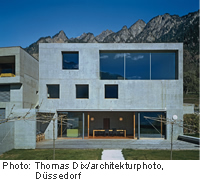House in Chur

High above the upper Rhine valley, on the slopes of Hochwang mountain, is this three-storey detached house. Situated within an area subject to a rigorous development plan by Bearth and Deplazes, this cuboid volume unfolds inside in a virtuoso sequence of spaces – from the living room at the top with a picture-book view of Chur and the mountains beyond to the large kitchen/dining room on the ground floor, which has direct access to the garden. Only a few materials were used in its construction, most of them left untreated, for example exposed concrete and solid walnut and larchwood. The special feature of this house, however, is its monolithic construction. Its sculpted outer form is produced not by intricate multiple layering, but through the use of a single, solid material – concrete. Depending on structural requirements or required insulation values, the walls are made of either ordinary concrete or insulation-grade structural concrete. The outer walls are 45 cm thick (U-value: approx. 0.58 W/m2K) and the roof slab 60–65 cm (U-value: approx. 0.4 W/m2K). As a result no further layers were necessary – no insulation, no plaster, no render, not even any metal flashing or gravel on the roof.
The insulating concrete from which the house was built was developed by the architect himself, in co-operation with two manufacturing firms. In this new product, gravel was replaced by expanded clay and sand by expanded glass. Like the expanded clay, the expanded glass pellets are insulating and lightweight. Their shape promotes good flowability and is necessary for controlling undesirable reactions between the glass and the cement in the concrete that could lead to spalling and rust-formation. No surface treatment was applied to the concrete, except for on the roof, where a UV-resistant, permanently elastic coat of plastic-modified cement slurry was applied to prevent moisture penetration. Although this special concrete cost about twice as much as conventional concrete, savings were made in terms of fewer trades on site, a shorter build time and because the outer skin is only a single-layer construction, not double.
